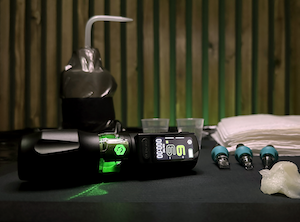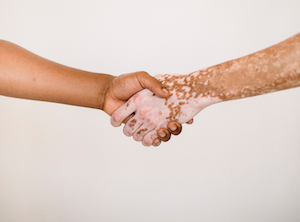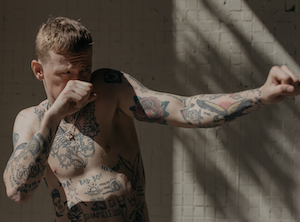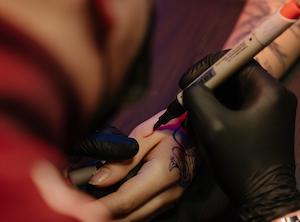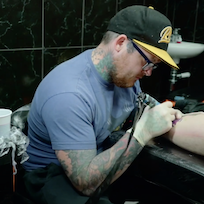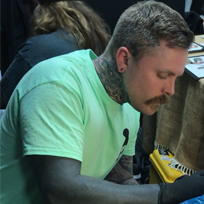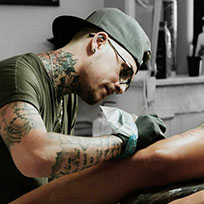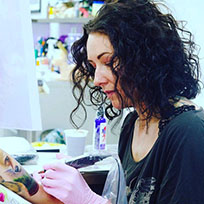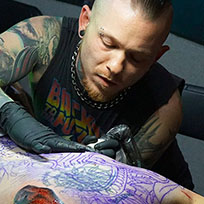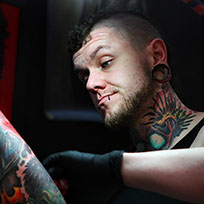Hygiene plays a crucial role in the daily life of a tattoo artist. To protect the health of your customer and yourself, you must take all measures to keep hygiene standards high.
1. Hygiene standards and general precautions
This begins with basic steps like proper hand hygiene, the use of sanitisers and disinfectants as well as furniture and equipment that is easily cleanable.
Hand Hygiene
Washing your hands is an essential part of your personal protection and should be done properly (see instruction here). You should wash your hands before and after touching your customer, before and after putting on gloves, and before and after all occasions you are handling your equipment. In doubt, it is better to wash your hands one more time than not. Don’t forget to have a good hand lotion ready when you are washing your hands often to avoid dryness and ruptures.
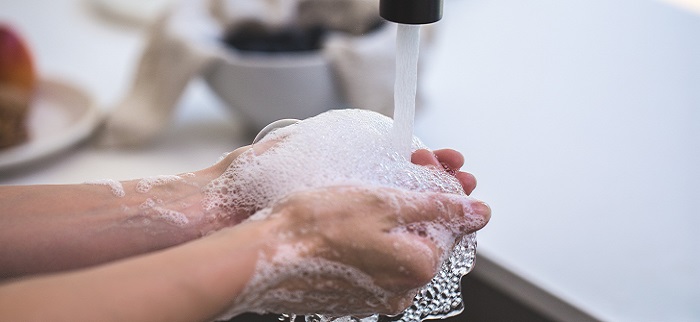
Illness
It also should be common sense that when your customer feels sick or shows symptoms of illness, the appointment (be it personal consultation or the actual tattoo date) should be postponed avoiding the risk of infection. The same applies to you, the tattoo artist. When you feel sick and are at risk of infecting your customer and/or co-workers you should cancel the appointment and set a new one. You do not want to be responsible for infecting your whole studio along with clients.
Vaccinations
Another thing that generally should be taken care of is that you and your teams’ vaccinations are up to date. In an environment of a tattoo studio, the risk of accidentally getting in contact with germs, blood and body liquids is very high and vaccinations take some of the risks away.
It is best to inform your customer beforehand on hygienic topics, as you are the professional and usually have a lot more knowledge than your customer. You should communicate that the appointment should be delayed if your customer is sick, along with information about preparations to take by the customer before the appointment. Furthermore, you should tell your client what they are allowed to touch and when and what not during the tattooing process. You don’t want your customer to pick or touch the open wound while you take a break and have them calling you two days later that the fresh tattoo is inflamed. Best way to avoid this is education. By telling your customer that germs and bacteria can easily enter their system by touching the open tattooed area. Also, you don’t want your customer to touch your workplace or any other equipment that could be prone to cross-contamination.
Furniture and Workplace
Your workplace and the furniture next to your working place should be suitable for tattooing. This means that it should be made from solid materials and therefore easy to cover as well as cleanable and wipeable. You should always cover your working materials and all surfaces that could be contaminated during the tattoo process and regularly clean all furniture.
There are special tattoo workstations you could have a look at, that was designed especially for the tattoo artist. Those tattoo workstations are not only easily cleanable but also offer other convenient features to keep your working environment tidy and clean.
(Tattoo) Equipment
Another important point that couldn’t be stressed enough is the use of reliable and safe tattoo equipment. Tattoo equipment should only be bought at trusted sources (like Barber DTS of course!) and abide by high-quality standards. It is your responsibility as an artist to create a positive experience for your customer and to keep them safe and happy. This can only be done by using high-quality equipment and sticking to the rules of hygiene you should have learned during your apprenticeship and in self-education.
Always remember: Tattooing is not only art. It is also a responsibility.
2. Gloves and Arm Sleeves
One of the most iconic PPEs associated with tattooing is disposable medical examination gloves. The most important tool a tattoo artist uses is his hands to stretch the skin of the customer and to navigate the tattoo machine. Gloves should be worn not only during the actual tattoo process but also on all other occasions when dealing with the customers’ skin (drawing on the skin, applying the stencil, cleaning the tattoo, wrapping the tattoo).
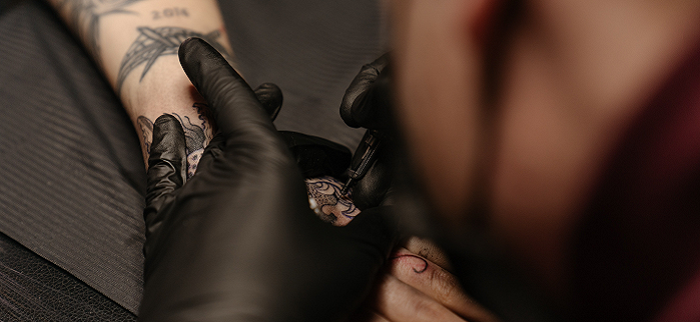
How to Work With Gloves
Always wash your hands before and after you use gloves to avoid contamination from your hands to the glove and vice versa. Gloves for tattooing should be changed for each new task and disposed of safely after use. If a glove gets ripped, punctured, or damaged in any way you need to instantly change to a new pair of gloves.
Always keep in mind that the longer you wear your gloves, the more the protective barrier will diminish. As a rule of thumb, you should at least change your gloves every two hours while tattooing to reduce the risk of losing the protection.
Different Types of Gloves
There are different types of examination gloves. For the material, you can usually choose between latex and nitrile examination gloves. Gloves made of vinyl (PVC) are generally not a good option for tattooing since the tactile feedback they provide is not sufficient.
The best tactile feedback you will get is from latex gloves (which are made of natural rubber). Latex offers a high level of comfort, stretchiness and fit, the best protection against bacteria and viruses. For that reason, latex gloves are the most popular tattoo gloves. However, latex is known to cause allergic reactions for some people.
The second-best choice in the context of tattooing is nitrile gloves. They don’t provide the same tactile response as latex but are still are a very good choice for tattooing. Also, the protection against bacteria and viruses is not as high as with latex gloves but still on a very good, acceptable level. We recommend using latex gloves if you do not have allergic reactions. Need we mention that you should always try to go for the powder-free ones!?
You also have the option to go for extended cuff gloves for added hygiene advantages against splattering ink or other fluids.
Disposable Arm Sleeves
For further protection, you should have a look at disposable arm sleeves to avoid having your arms exposed to blood and pathogens. Since your arms are your most important tool, oftentimes there are little wounds that could serve as an entry gate.
3. Face Masks
Face masks didn’t play an as bigger role in the tattooing world across Europe as they do now. In Asia and with Asian tattoo artists, face masks are much more common to protect others from getting infected. Until now, face masks were mostly used if the tattoo artist had symptoms of sickness but was still able to work, to reduce the risk of infection for the client. With recent developments, awareness for PPE has risen and face masks will find their way into the daily life of tattoo artists much more than before.
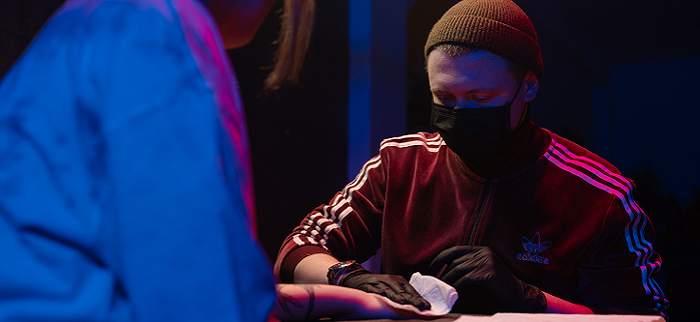
Different Levels of Protection
Face masks in professional environments like tattoo studios should always be disposable because only this way is it guaranteed that the pathogens they have been exposed to are disposed of.
Self-made masks or those made from cloth are non-regulated masks without certification and there is little knowledge to what degree they provide any protection. They build a physical barrier between the mouth and nose of the wearer and potential contaminants in the immediate environment, so they are holding off pathogen from the wearer and provide some protection against transmission of respiratory illnesses. These masks are the best choice for the general public to prevent the spreading of viruses and bacteria. But they do not provide good protection for professionals and should not be used in professional environments. Self-made and cloth masks are not personal protective equipment (PPE).
As a tattoo artist, you and your customer should wear surgical masks that are made from non-woven fabric. They help to block large-particle droplets, splashes, sprays, or splatter that may contain viruses and bacteria, keeping it from reaching the wearer’s mouth and nose. If worn by both, the artist and customer, they provide a good level of protection and come at a bearable price.
Professional face masks with filtration are regulated with EN 149:2001+A1:2009 and categorised in 3 protection levels. Named FFP (Filtering FacePiece) they provide respiratory protection on different levels according to their numbers 1-3. The higher the number, the better protection they provide. FFP masks have mainly been developed and certified for work protection to avoid inhalation of particles but offer protection against pathogens to some degree.
Because these masks are critical supplies, they must continue to be reserved for health care workers and other medical first responders when stocks are low.
FFP1 (Internal leak rate: Maximum 22%; Aerosol filtration percentage: 80%) masks do not provide a strong enough entrance barrier for bacteria or viruses to be used. So, these masks are not suitable for personal protection but build a physical barrier and can be used to protect others from getting infected by the wearer. Recognizable by the typical yellow elastic band.
FFP2 (Internal leak rate: Maximum 8%; Aerosol filtration percentage: Minimum 94%) masks can be used as effective protection against influenza viruses like SARS and SARS-CoV-2 (known as Corona-Virus) and common bacteria. These masks would be a good choice for tattoo artist and customer for the influenza season to prevent infection with respiratory transmitted diseases like the recent COVID-19 outbreak. Recognisable by the typical blue or white elastic band.
N95 (USA, Canada, Australia, NZ and Japan) and KN95 (China) face masks offer the same protection as FFP2 masks, but under different names.
FFP3 (Internal leak rate: Maximum 2%; Aerosol filtration percentage: Minimum 99%) masks provide the highest level of protection against particles. Those masks can hold off most of the pathogens when used properly and can be worn as personal protection equipment. Recognisable by the typical red elastic band.
Proper Use of Masks
Before putting on the mask it is crucial to properly wash your hands (for instructions click here). The mask should fit as tight as possible to provide maximum protection. They have a metal tab to easily adjust the mask to the bridge of the nose for proper fit. The mask should not be touched when in use as the virus is not able to penetrate the mask but can be found on the surface when exposed. If this happens by accident, hands must be washed immediately. The protection is only given when the mask is dry, so you should replace it as soon as it gets wet. The mask must be removed from the back without touching the front to avoid contamination on the hands. After removal, you must wash your hands again. FFP masks are only certified for single-use and should not be reused.
4. Eye protection
A point that is disregarded often is the protection of eyes. The eyes serve as an entry gate for viruses and bacteria and should be protected during the tattoo process. This can be done on a basic level with glasses (with clear lenses) or special eye protective equipment.
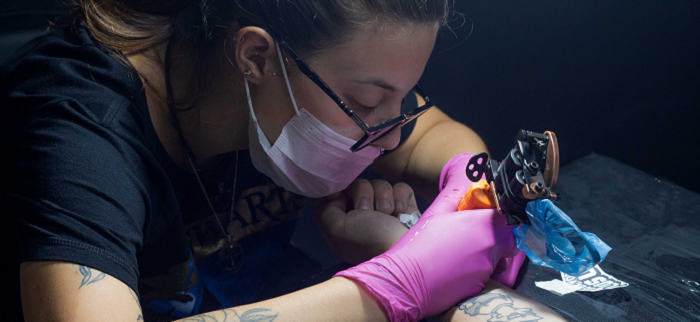
Wearing glasses, you should avoid readjusting them with your hands during the tattoo process. You should generally avoid touching your face as bacteria, germs and viruses could find their way into your system doing so.
A better choice than wearing glasses are goggles because they have a tighter fit at the edges to prevent splashes and pathogens entering the eyes.
Full face protection visors provide excellent protection against body fluids, blood splashes and sprays because of the strong physical barrier. On first sight, they might look funny but for tattooing, they are perfect. They do not only keep all kinds of particles away from your face but also allow you to have full sight without being restricted by frames of glasses. Also, they still allow you to wear your (corrective) eyewear underneath.
Full-facepiece respirators are considered the best form of eye protection but are a little over the top in the context of tattooing. This PPE is should be reserved for medical workers.
5. Protective aprons
PPE doesn’t stop at your face and hands. Your other body parts and clothes should be covered as well. If you have open wounds, it is crucial to have them covered thoroughly to avoid any infections. Working close with human beings and the unavoidable body fluids, you need to protect your clothes not only from soiling but also from contamination with pathogens, as many pathogens can survive on fabric. You don’t want to carry them around after work.
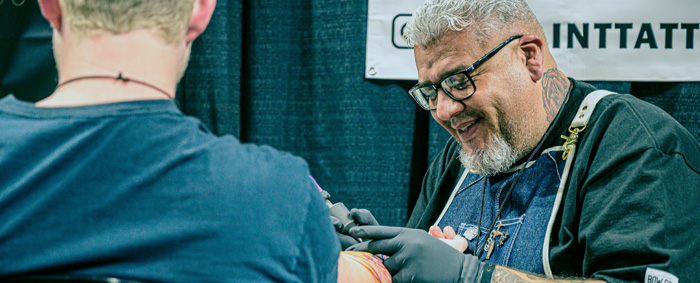
So, either you have special working clothes, which you will change and clean for each client and when finished with work. Or you take advantage of protective aprons. You can choose between reusable aprons which are mostly made from leather, waxed canvas or vinyl/disposable, single-use aprons.
Reusable aprons should be cleaned thoroughly after use to avoid cross-contamination. The better choice is to combine those aprons with disposable aprons for a second layer of protection.
Disposable aprons can be used on their own and provide good protection of skin and clothes, as well as keeping your clothes clean. After use, you can easily dispose of them (keep care of good hygiene doing so). Keep in mind to only buy protective gear from trusted shops. Only this way you can be sure to have the quality at hand you need.
6. Footwear
During the tattoo process, it is recommended to wear solid footwear to keep your feet clean from dripping liquids and accidentally falling equipment. You don’t need to wear security boots but sandals, flip-flops and all other open shoes should be avoided. This is especially tempting in the summertime, but keep in mind, this is also the period where you spend a good amount of time barefoot or in open shoes anyway and this often leads to little ruptures you don’t want to have exposed while tattooing.
7. Conclusion
In this article, we took you through different options of PPE (Personal Protection Equipment) and the basics of hygiene that every tattoo artist should be aware of and practice. Rules of hygiene and good personal protection equipment, as well as professional tattoo equipment, are the cornerstones of your craft. Keep sanitised!













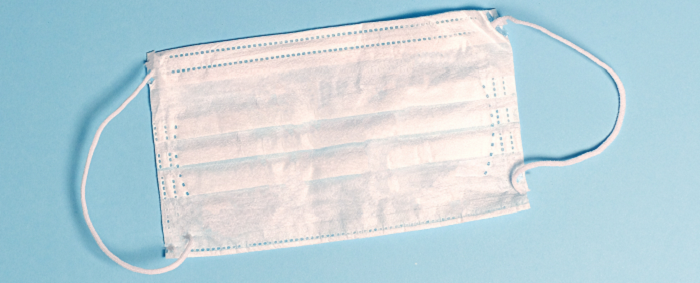
 What Is A Prince Albert Piercing?
What Is A Prince Albert Piercing?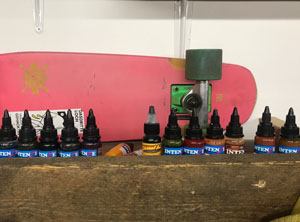 The Best Tattoo Ink 2024
The Best Tattoo Ink 2024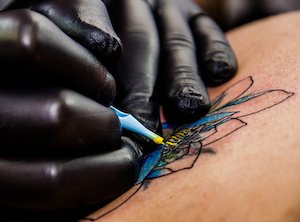 Tattooing Over Stretch Marks, Moles, Scars And Other Skin Conditions
Tattooing Over Stretch Marks, Moles, Scars And Other Skin Conditions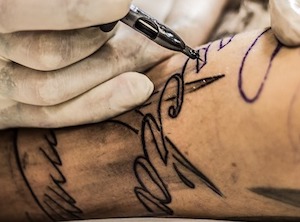 11 Best Fonts For Tattoos 2022
11 Best Fonts For Tattoos 2022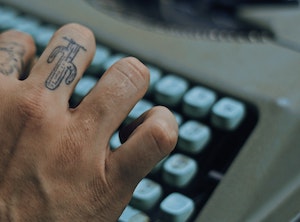 Advice For An Itchy Tattoo
Advice For An Itchy Tattoo
